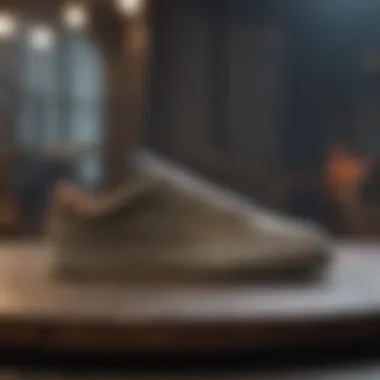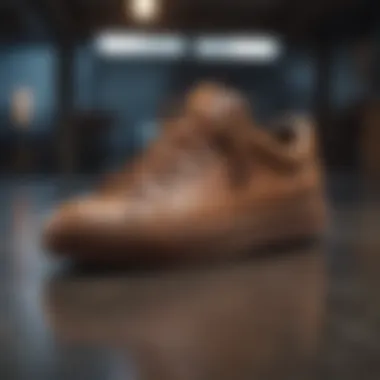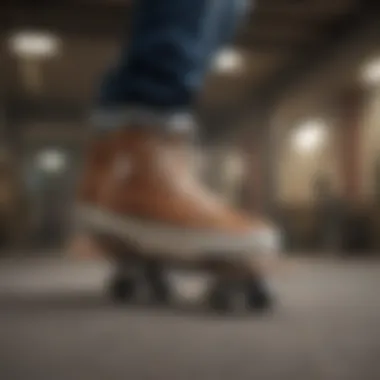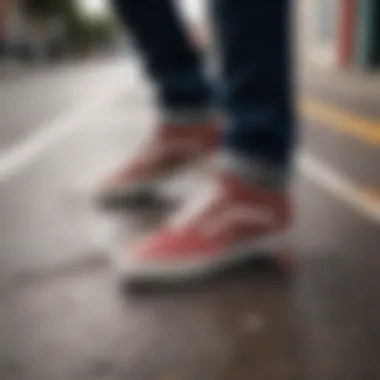The Evolution of Path Skate Shoes: Performance Meets Culture


Intro
The journey of skate shoes has been both innovative and intriguing. This article focuses on the evolution of path skate shoes, detailing their significance within the skateboarding culture and their development over time. It aims to highlight how these shoes have become symbols of personal expression, merging high performance with unique styles. From their inception to current trends, we will delve into the technology and design innovations that have transformed these shoes into essential gear for skaters.
Techniques and Tips
Understanding the specifics of path skate shoes' design and fit can enhance the skater's experience. The choice of skate shoes can significantly impact both performance and comfort during rides. Here are some important techniques and tips for selecting the right pair:
Skill Development
Skaters should start by recognizing their skill level and the type of skating they wish to pursue. Beginners might benefit from shoes that offer more padding and support. As skills progress, the focus can shift to shoes that provide better board feel and flexibility.
Practical Techniques
When trying on path skate shoes, consider the following:
- Ensure a snug fit without pain.
- Walk around in the shoes to check for any discomfort.
- Pay attention to the grip and surface material, as these greatly impact performance.
These elements can affect overall performance, particularly during tricks or while landing.
Common Mistakes to Avoid
Some typical errors can lead to dissatisfaction with shoe performance. Beginners frequently select overly rigid or bulky shoes that can hinder movement. Similarly, opting for shoes based solely on aesthetic appeal, without considering practicality, can lead to issues on the board. Always prioritize comfort and fit over looks.
Gear and Equipment
Choosing the right gear is critical for any serious skater. Path skate shoes are not only designed for style but for essential performance aspects. Here’s a closer look at gear considerations:
Essential Gear for Beginners
New skaters should invest in durable shoes that offer both protection and support. Brands like Vans and Nike SB have models ideal for beginners, combining style with functionality. A good skate shoe should have:
- A reinforced toe for durability.
- Sufficient padding for shock absorption.
- A solid grip on the outsole.
Latest Innovations and Trends
In recent years, many brands have made strides in technology for skate shoes. Features such as responsive cushioning and breathable materials have become standard, enhancing performance during extended skating sessions. Watch out for limited editions that often blend fashion with function, catering to the evolving tastes of the skating community.
Reviews and Comparisons
Before making a purchase, skaters can benefit from online reviews. Platforms like Reddit offer valuable insights from users discussing their experiences with various models, making it easier to choose a reputable brand that meets personal needs.
Safety Measures
While engaging in skateboarding, safety should always come first. The right shoes can play a significant role in injury prevention.
Essential Safety Gear
In addition to path skate shoes, skaters should invest in safety pads and a helmet. Essential safety gear includes:


- Wrist guards
- Knee pads
- Elbow pads
These items help mitigate risks during falls and tricks, protecting vulnerable areas.
Best Practices for Safe Participation
Understanding your limits is crucial. Start with simpler tricks before attempting more complex maneuvers. Regularly check your gear for any wear and tear that could lead to accidents.
Injury Prevention and Management
Injuries are a part of extreme sports. Skaters should always warm up before skating and be cautious of how they land. Knowing basic first aid can be beneficial when handling minor injuries.
Finale
The evolution of path skate shoes is a reflection of both technological advancement and cultural shifts. These shoes embody values such as individuality, creativity, and performance, continuing to inspire skaters around the world. By understanding their history, design innovations, and choosing wisely, skaters can enhance their riding experience while staying true to the culture.
Preface to Path Skate Shoes
Path skate shoes represent a unique fusion of performance and culture within the skateboarding community. Their evolution has not only reshaped how skaters approach their craft but has also influenced the broader streetwear landscape. Understanding the nuances of these shoes helps pinpoint the needs of skaters, serving as a gateway into the intricacies of skateboarding apparel.
Over the years, characteristics of path skate shoes have become increasingly refined. Factors such as grip, cushioning, and durability play critical roles in performance. Additionally, these shoes serve as a canvas for personal expression. Skaters choose styles that reflect their individuality, blending functionality with aesthetic appeal.
When discussing path skate shoes, it is essential to consider both the athletes' needs and the brand's vision. Skaters require reliable footwear that enhances their skills, while brands aim to create products that resonate with the culture. The implications of this dual focus extend beyond the board, creating a narrative that captivates both wearers and observers.
Understanding Skate Shoe Essentials
To fully grasp what makes path skate shoes indispensable for skaters, it is vital to identify the core components that contribute to their design and effectiveness.
- Grip: Skate shoes are engineered with specialized rubber outsoles that provide superior traction. This feature is critical, as it allows skaters to perform tricks without the fear of slipping.
- Cushioning: Impact absorption is another essential element. Advanced cushioning technologies help protect skaters' feet during landings, greatly reducing the risk of injury.
- Support: Ankle support varies from shoe to shoe, but it is crucial for providing stability during high-impact moves. Different designs cater to both high-top and low-top preferences, offering varying levels of support.
- Durability: Skate shoes must withstand wear and tear from trick execution and rough terrains. Materials such as suede and canvas are often used for their resilience but still need to be lightweight for performance.
- Style: Aesthetic considerations include colorways and branding. Skaters often gravitate towards shoes that allow them to express their style and align with their identities.
By diving into these essentials, we appreciate skateboarders’ demand for performance-focused footwear that does not compromise on culture and identity.
Historical Context
In the realm of skateboarding, understanding the historical context of path skate shoes is essential to appreciate their evolution and significance. The journey of these shoes reflects broader trends in both fashion and functionality, illustrating how they became integral to skateboarding culture. Historical context allows us to see the path skate shoes evolve not merely as footwear but as symbols of identity and performance within the skateboarding community.
Roots in Skateboarding Culture
The roots of path skate shoes are firmly embedded in the vibrant and rebellious culture of skateboarding that began to take shape in the late 20th century. Initially, skate shoes were adapted from existing sneaker designs, often lacking the technical features required for optimal performance. Despite this, skaters embraced these shoes, turning them into a cultural statement.
Key characteristics often found in early skate shoes included a flat sole and durable materials, which provided better grip and board feel. As skaters sought to express their individuality, the aesthetics of skate shoes became just as important as their functionality. This dual focus on performance and style marked a significant turning point. It created a demand for specialized skate footwear that could withstand the rigors of street skating and vert ramps.
Milestones in Skate Shoe Evolution
Several notable developments have defined the evolution of path skate shoes over the decades.
- Introduction of Reinforced Designs: In the 1970s, brands like Vans and Converse began to introduce skate shoes with reinforced stitching, padding, and grippy soles. This set a new standard and catered directly to the unique needs of skaters.
- Technological Innovations: The 1980s brought forth technological advancements, such as shock-absorbing materials and specialized rubber compounds. This increase in performance-focused features attracted professional skaters and amateurs alike.
- Brand Collaborations: In the 1990s, collaborations between skate brands and high-fashion designers emerged, pushing the boundaries of skate shoe design. This trend solidified the position of skate shoes in popular culture, making them more than just functional footwear but artifacts of cultural expression.
- Sustainability Trends: Recently, there has been growing awareness around sustainability. Path skate shoe brands increasingly consider eco-friendly materials and production processes, reflecting a broader societal shift towards responsible consumerism.
As path skate shoes evolved, they mirrored shifts in skateboarding culture itself, encapsulating the spirit of innovation and individuality. This historical context enriches our understanding of the shoes today, revealing layers of performance, identity, and community connection.


Technology Behind Path Skate Shoes
The technology integrated into path skate shoes is essential for both performance and comfort in skateboarding. As skaters continuously push their limits, the demands on their footwear increase. This section highlights the importance of various technologies employed in path skate shoes and how they enhance the overall skating experience.
Material Innovation
Material innovation stands at the forefront of what's possible in skate shoe design. Traditional skateboard shoes often suffered from wear and tear due to the rigorous activities they were subjected to. Path skate shoes leverage advancements in materials to provide both durability and flexibility. High-quality suede and leather, often utilized in the upper construction, deliver a balance of support and breathability.
Moreover, technologies such as reinforced toe caps prevent abrasion during tricks, extending the life of the shoe. Lightweight cushioning materials, like EVA foam, contribute to impact absorption, providing necessary comfort during hard landings. These factors collectively ensure that skaters can focus on their craft without the distraction of inadequate gear.
Design Features Enhancing Performance
Design features play a crucial role in the performance of path skate shoes. A well-designed skate shoe offers superior grip, comfort, and support. A common feature in these shoes is the use of rubber outsoles designed for optimal traction. The tread pattern often reflects the need for both grip and slide, allowing for fluid transitions between skating styles.
In addition, features such as padded collars and tongues ensure a snug fit, reducing the risk of blisters and discomfort that can arise during long sessions. Some models even incorporate a drop-in midsole, which allows for additional cushioning adjustments as skaters find their preference.
"The fusion of design and technology in skate shoes reflects the evolution of skating itself, focusing on performance while staying true to culture."
Sustainability Initiatives
In recent years, there has been a noticeable shift towards sustainability in the design of path skate shoes. Brands are recognizing their responsibility towards the environment and are making concerted efforts to produce eco-friendly products. These initiatives may involve the use of recycled materials in production or low-impact manufacturing processes.
For instance, some companies are researching natural alternatives to synthetic materials, ensuring that the shoes they produce are not only high performing but also mindful of their ecological footprint. As consumers become increasingly aware of sustainability, brands that prioritize eco-friendly practices can expect loyalty from the environmentally-conscious skater community.
The shift towards sustainability is more than just a trend; it signifies a broader movement within the skateboarding culture towards ethical and responsible consumption.
Cultural Significance
The cultural significance of path skate shoes extends far beyond their basic function as footwear. These shoes have evolved into an essential symbol of identity within the skateboarding community and a representation of the sport's growth over the years. The connection between skate shoes and personal expression is profound, intertwining with the values and lifestyles of skateboarders.
Influence on Skateboarding Community
Path skate shoes have a notable effect on the skateboarding community. They support not only the physical needs of skaters but also their social and cultural identities. When a skater puts on a pair of path skate shoes, they are not just choosing footwear; they are aligning themselves with a way of life that encourages creativity, rebellion, and freedom. Many skaters endorse certain brands, forming a bond with specific models that reflect their unique styles and preferences. This choice is often driven by functionality, durability, and aesthetics.
Furthermore, skate shoes serve as a canvas for self-expression. Many brands collaborate with artists or release limited editions, which often feature original designs and cultural references. This trend resonates deeply, as it allows skaters to showcase their individuality and passions. The influence of path skate shoes can be seen in many skate parks, where the varied designs worn by skaters tell a story of diversity and personal choice.
The communal aspect is just as vital. Events centered around skateboarding, such as competitions and gatherings, often see brands amplifying their presence through sponsorships. This sponsorship does not merely provide financial backing; it cultivates a sense of togetherness and shared values among participants. Through their designs and marketing strategies, brands acknowledge the culture surrounding skateboarding, forging deeper ties with their audience.
Representation in Media and Art
The representation of path skate shoes in media and art is a significant aspect of their cultural significance. Skateboarding has often been featured in films, documentaries, and music videos. These representations go beyond mere visuals of tricks and stunts; they often portray the underlying culture. Path skate shoes frequently take center stage in these media portrayals, symbolizing a lifestyle that values raw passion and creativity.
Artistic expressions often draw inspiration from skate culture. Street art and graffiti, which are common in skateboarding scenes, frequently showcase skate shoes as a motif. Many times, these works reflect themes of rebellion, resilience, and community. Notably, the influence extends into music as well. Genres like punk rock and hip-hop closely intertwine with skate culture. Path skate shoes are visible in various music videos or performances, cementing their place as an emblem of youth culture.
Path skate shoes also intersect with social issues and movements. They have become a medium for messages around identity, diversity, and inclusion within the skateboarding community. Limited edition styles often make statements that align with broader cultural conversations, promoting awareness about important matters. This strategic integration of path skate shoes into art and media enriches the cultural narrative, allowing skaters to feel represented and connected to larger societal dynamics.
In summary, path skate shoes hold significant cultural value, shaping both individual and community identities in the skateboarding world. Their role in the media and art landscape enhances their impact, as they embody the ethos of an entire generation of thrill-seekers, making them more than just footwear.
Consumer Insights
The section on consumer insights holds significant weight in understanding the dynamics within the skate shoe market. By scrutinizing consumer perspectives, preferences, and feedback, one can gauge not only what drives sales but also what shapes the evolution of skate footwear. This exploration unveils the motivations behind purchasing decisions, hence linking the role of path skate shoes to a broader cultural narrative.


Understanding consumer behavior illuminates why certain shoes resonate more with riders. It highlights the blend of functionality, style, and brand ethos that appeals to the skateboarding community. By examining preferences, it is apparent that a shoe must not only perform well but also express individuality and identity. Consequently, this consciousness governs the choices made by an informed audience who value both aesthetics and practicality in their skate shoes.
Choosing the Right Skate Shoes
Choosing the right pair of skate shoes is crucial for both performance and personal expression. Skaters often have specific criteria when selecting shoes. These criteria can include:
- Fit and Comfort: Shoes should offer a snug yet comfortable fit to allow for better control and maneuverability while riding.
- Durability: Skate shoes must withstand harsh conditions. High-quality materials contribute to the longevity of the shoes.
- Grip and Traction: Outsoles need to provide adequate grip on the board. This ensures that tricks can be performed with confidence.
- Style: The design of the shoe can reflect a skater’s personal style, making aesthetic value equally important.
Many brands offer specialized features targeting specific needs. For example, shoes with reinforced Ollie areas protect against wear during tricks. Similarly, cushioning technologies can enhance comfort during high-impact activities. Ultimately, the right choice supports a skater’s skills while elevating their personal brand within the culture.
Consumer Reviews and Experiences
Consumer reviews are a rich source of information that influences both potential buyers and manufacturers. These insights can shape product development and marketing strategies. They provide first-hand accounts of how path skate shoes perform in practical scenarios.
Positive reviews often emphasize durability and comfort, leading to a repeated purchase among loyal consumers. Negative reviews, conversely, can highlight shortcomings that manufacturers need to address. Common feedback elements include:
- Quality of Material: Information regarding how well the shoes hold up after extended use is pivotal.
- Comfort Level: Feedback on the shoe's cushioning and fit helps potential buyers gauge suitability.
- Style and Aesthetic Appeal: Consumers often share their experiences with the shoe’s visual elements in relation to their skateboarding community.
"A great skate shoe should not only look good but also make you feel confident on the board. Performance and style go hand in hand."
Reviews can be found on various platforms like Reddit and Facebook, where community discussions provide further depth. Gathering these insights not only aids consumers in making informed decisions but also shapes the branding strategies for companies, reinforcing the symbiosis between consumer preferences and product design.
Future Trends in Skate Shoe Design
Future trends in skate shoe design are crucial for understanding the evolving landscape of skateboarding culture and performance. As the industry adapts to technological advancements and shifts in consumer behavior, skate shoe designers are under pressure to innovate. This section examines key elements shaping future designs, considering aspects like functionality, sustainability, and style.
Emerging Technologies
The integration of emerging technologies significantly influences the development of skate shoes. Companies now invest in smart materials that offer enhanced performance and comfort. For example, breathable fabrics that adapt to temperature changes improve airflow, keeping feet cool during intense sessions.
Key technologies shaping skate shoe design include:
- 3D printing: This allows for personalized fits, enabling brands to create shoes tailored to individual foot shapes. This could reshape the way skaters choose their footwear.
- Responsive cushioning: Innovations in foam technology provide better shock absorption, reducing the impact on joints. Brands like Nike are leading with their React foam technology.
- Sustainable materials: As environmental consciousness grows, many brands are exploring options such as recycled plastics and organic cotton. This aligns with the values of many skaters who care about their footprint.
Shifts in Consumer Preferences
Consumer preferences are shifting rapidly due to changing lifestyles and values. Skaters are increasingly looking for footwear that not only performs but also represents their identity. This change pushes brands to align more closely with the culture of skateboarding.
Considerations in consumer preferences include:
- Versatility: Skaters want shoes that transcend the skatepark, suitable for casual wear and lifestyle use. Comfort and style are now equally important as performance.
- Brand values: Consumers are drawn to brands that demonstrate social responsibility. Ethical production, community engagement, and inclusivity in marketing resonate strongly.
- Customization: The demand for personalized options is rising. Skaters prefer shoes that reflect their unique style. Many brands are now offering customization options online.
"Skate shoes are a canvas for self-expression. They should reflect the wearer's personality beyond just performance."
As the industry evolves, manufacturers must pay attention to these trends. In doing so, they bridge the gap between high-performance footwear and cultural expression, catering to both functionality and personal identity. The next few years promise exciting changes in the skate shoe market, shaping a future where innovation meets culture.
Closure
The conclusion serves as an essential component in understanding the holistic narrative surrounding path skate shoes. Emphasizing their significance, this section compiles insights drawn from previous discussions on historical context, technological advancements, and cultural relevance. By encapsulating these elements, readers gain a comprehensive perspective on how path skate shoes blend performance and culture effectively.
The Path Forward
The future of path skate shoes looks promising, influenced by both emerging trends and evolving consumer preferences. It is crucial to recognize some key aspects that will shape this future:
- Innovation in Materials: As brands continue to invest in research, the choice of fabrics and components will likely shift towards more sustainable and high-performance options.
- Customization Opportunities: Skaters are increasingly seeking shoes that reflect their personal style. Brands may respond by providing options for customization, allowing for a unique connection between the consumer and the product.
- Technological Integration: Advancements in technology may lead to the integration of features like smart materials, which adapt to the skater's movements, enhancing overall performance.
- Focus on Inclusivity: With the growth of skateboarding culture, brands may focus more on producing a wider range of sizes and styles to cater to a diverse audience.
Understanding these factors is vital for skaters and enthusiasts. It enables them to align their choices with upcoming trends, ensuring they remain part of a dynamic and ever-evolving landscape. The journey of path skate shoes, from their inception to their future, continues to bridge the gap between high-level performance and cultural engagement.







